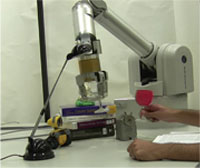| Learning Fast Grasping Strategies using Multiple Attractors based Dynamical Systems Christophe Paccolat (MT) This project will deal with learning of fast and coordinated hand-arm grasping schemes under the Programming by Demonstration framework. The planning and control of the complete hand-arm system is extremely non-linear and complex due to its high dimensionality. Moreover, in the event of a sudden perturbation, the controller needs to update the motion of both hand and arm in order to successfully form the grasp around the new target. The student will use techniques based on Coupled Dynamical Systems with single and multiple attractors in order to achieve fast and reliable responses. The whole project will comprise of implementing the current state of the controller on the 7-dof WAM arm with 4-dof Barrett Hand (30%), learning multiple object affordances into a multi-attractor GMM (40%), developing a C++ library for multiple attractor GMR (30%). The detailed workflow would be as follows: 1) Exporting the current controller based on coupled dynamical systems from iCub to the WAM platform. This will require a study of the morphology of the two robots and mapping the learned model accordingly between the two. This will be followed by implementing an experiment involving fast perturbation. 2) Learning multiple affordances of a complex object into a single GMM with multiple attractors. A simple toy example developed in MATLAB would be developed as proof of concept. 3) Developing a C++ library for learning multiple attractor GMMs. Project: Master Project at EPFL Period: 21.02.2011 – 09.07.2011 Section(s): MT Type: Theory(40%), Robot Implementation (30%), Programming (30%) Knowledge(s): Dynamical Systems, MATLAB, C++ Subject(s): Imitation Learning, Dynamical Systems, Gaussian Mixture Regression Responsible(s): Ashwini Shukla, Aude Billard | |
Development of a Control Module for Learning Robot Minigolf Hitting Motions on Advanced Fields Adrien Béraud (CH) In the LASA laboratory, a system for teaching a robotic arm how to play minigolf has been developed. The minigolf skill requires two parts: 1) a basic hitting motion model 2) a hitting motion adaptation model. The latter is used to set the parameters of the former such that the robot hits the ball with appropriate hitting angle and hitting speed given the position of the ball. The use of a stereovision system to track the ball enables the robot to solve all challenges involved in playing minigolf autonomously, i.e. tracking the ball, choosing hitting angle and hitting speed, and hitting the ball. This project aims at extending the range of playable fields by improving various aspects of the system. The focus will be on implementing a selfimprovement mechanism (to allow the robot to learn from its experience) and investigating alternative models of the hitting motion. This short video gives an overview of the system in its current state. Project: Semester Project Period: 20.09.2011 – 20.01.2012 Section(s): EL IN ME MT Type: 30% experiments, 50% software, 20% theory Knowledge(s): Matlab, C++, Machine Learning, Control Systems Subject(s): Machine Learning, Control Systems Responsible(s): Klas Kronander, Seyed Mohammad Khansari-Zadeh |  |